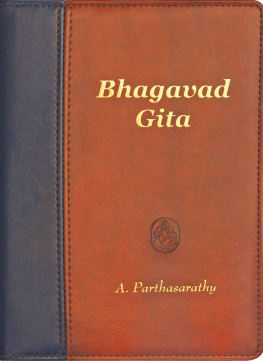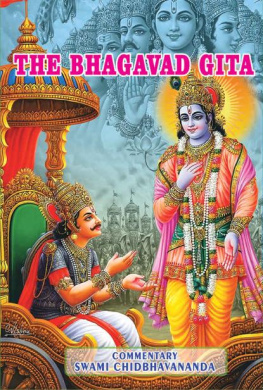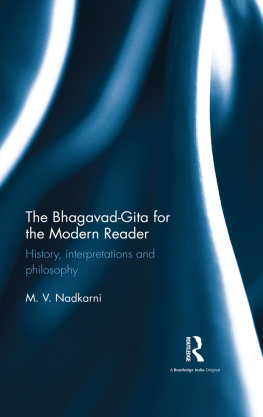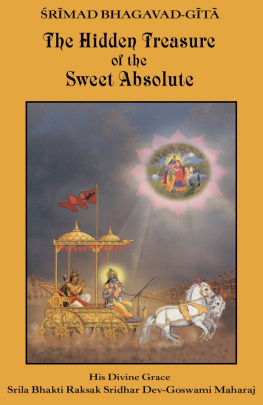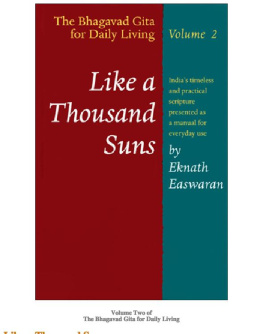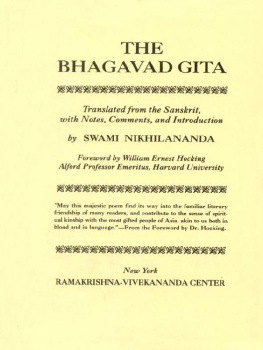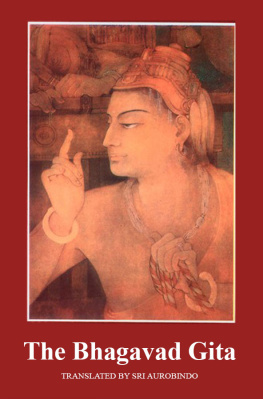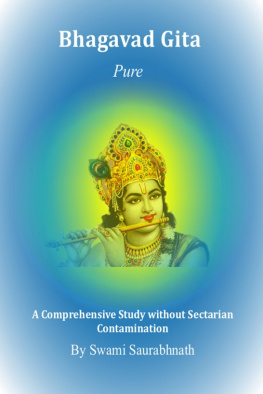A. Parthasarathy - Bhagavad Gita
Here you can read online A. Parthasarathy - Bhagavad Gita full text of the book (entire story) in english for free. Download pdf and epub, get meaning, cover and reviews about this ebook. year: 2014, publisher: A. Parthasarathy, genre: Religion. Description of the work, (preface) as well as reviews are available. Best literature library LitArk.com created for fans of good reading and offers a wide selection of genres:
Romance novel
Science fiction
Adventure
Detective
Science
History
Home and family
Prose
Art
Politics
Computer
Non-fiction
Religion
Business
Children
Humor
Choose a favorite category and find really read worthwhile books. Enjoy immersion in the world of imagination, feel the emotions of the characters or learn something new for yourself, make an fascinating discovery.
- Book:Bhagavad Gita
- Author:
- Publisher:A. Parthasarathy
- Genre:
- Year:2014
- Rating:4 / 5
- Favourites:Add to favourites
- Your mark:
- 80
- 1
- 2
- 3
- 4
- 5
Bhagavad Gita: summary, description and annotation
We offer to read an annotation, description, summary or preface (depends on what the author of the book "Bhagavad Gita" wrote himself). If you haven't found the necessary information about the book — write in the comments, we will try to find it.
Bhagavad Gita — read online for free the complete book (whole text) full work
Below is the text of the book, divided by pages. System saving the place of the last page read, allows you to conveniently read the book "Bhagavad Gita" online for free, without having to search again every time where you left off. Put a bookmark, and you can go to the page where you finished reading at any time.
Font size:
Interval:
Bookmark:
GITA
A. PARTHASARATHY
Copyright Notice. Copyright with respect to this item and all the contents contained in this book belongs to the Author and the Publisher A. Parthasarathy. ALL RIGHTS RESERVED. This item contains material protected under domestic and international Copyright Laws and Treaties. No part of this material may be reproduced or transmitted in any form or by any means without express written permission from the Author. No part of this material may be otherwise modified, copied, reproduced, republished, uploaded, posted, transmitted or distributed in any form. You may only use this material for your own non-commercial use. Any resale or offer for resale of this material and any other commercial use that may violate Authors legal rights is strictly prohibited. This material may only be distributed, offered for sale or sold by an authorized distributor or seller in your region, subject to and as limited to express written authorization from the author. This material may not be exported to another region to be offered for and/or for sale/resale. Any exportation from or importation of this material to another region without the Authors express authorization is illegal and is a violation of Authors legal rights. The Author, at his discretion, has the right to seek all legal remedies including but not limited to monetary damages to the maximum extent permitted by law.
ISBN No: 978-93-81094-13-6
Published by:
A. Parthasarathy
1A Landsend
Mumbai 400 006
India
www.vedantaworld.org
Sasktam is transliterated in the English alphabet according to the scheme adopted by the International Congress of Orientalists at Athens in 1912 and, since then, generally acknowledged and accepted universally. The key of this scheme is as follows:

* There are no exact English equivalents for the letters listed with an asterisk
The Bhagavad Gt literally means Song of the Lord. The text begins with the word dharma and ends with the word mama. Mama means my and dharma, essential Being. Together they mean my essential Being. It signifies the theme of the Gt. That the purpose of life is to realise ones essential Being. To discover the supreme Self within. Attain spiritual Enlightenment.
The Gt is the philosophical part of the great epic Mahbhrata. The epic is the work of sage Vysa. It contains nearly a hundred thousand verses. The central narrative in the epic speaks of the rivalry between two royal families, the Pavas and the Kauravas who were cousins. The Pavas were five brothers, moral and virtuous. The Kauravas were a hundred brothers, immoral and vicious.
Duryodhana, the eldest of the Kauravas, provoked by jealousy at the wealth and renown of the Pavas, continuously harassed them. He invited Yudhihira, the eldest of the Pavas, to a game of dice and won by deceit. As his prize he stripped the Pava princes of all their possessions. And stipulated the five princes and wife Draupad live in the forest in exile for twelve years. At the end of twelve years they were to remain incognito for another year, undetected by the Kauravas. During these thirteen years Duryodhana would rule the kingdom. If the Pavas served this exile and remained undiscovered in the thirteenth year, the kingdom would be restored to them. The Pavas complied with all these terms and claimed their kingdom at the end of the thirteenth year. But Duryodhana refused to abide by the agreement. The wise men of the land tried to negotiate for a peaceful settlement. Regardless, Duryodhana was viciously obstinate and drew the Pavas to battle.
Prince Arjuna, one of the Pava brothers, and Duryodhana both approached Lord Ka simultaneously to join them as an ally. In a brilliant move Ka offered help to both parties. One side would have his entire army; the other side would have him unarmed. Arjuna heartily accepted Ka. And Duryodhana was happy to have the army.
On the battlefront, Prince Arjuna, one of the outstanding warriors of the time, asked Ka, his charioteer, to drive the chariot between the two armies. There he saw his own guru Droacrya, his grandsire Bhma and a host of his dear friends and relatives all arrayed on the enemy lines. Arjunas emotions suddenly overwhelmed him. He was mentally shattered, intellectually paralysed. And the great warrior could not fight. He laid down his bow and arrow and surrendered to Lord Ka for guidance. It was at that point of emergency that the Lord delivered the sermon of the Bhagavad Gt to Arjuna. The philosophy of the Gt revived and recharged the Pava prince with a higher vision. Towards the end of the last chapter Arjunas delusion vanished. He then picked up his weapons, fought the war and emerged victorious.
The story of the Mahbhrata has a philosophical significance. The Pavas and the Kauravas represent the positive and the negative qualities of an individual. The Kauravas having larger forces than those of the Pavas suggests that the negative generally outnumber the positive. The civil war fought between the Pava and the Kaurava forces symbolises the conflict between the higher and lower natures within a human being.
The goal of human existence is the realisation of the supreme Self within. To realise the Self you need to rise above your involvement with the good and the bad forces of the world. Non-involvement with the good and the bad is essential for attaining spiritual knowledge. That is symbolised by Arjuna receiving the sermon of the Gt in the chariot between the Pava and the Kaurava armies.
The chariot also has a deeper connotation. It is an allegory taken from the great Vedic text Kahopaniad. The chariot and horses represent the human body and sense organs. The reins symbolise the mind, the charioteer the intellect and the rider the individual. If the charioteer falls asleep, the reins become loose and the horses go out of control. It results in the destruction of both the chariot and rider. So too, when the intellect is not alert, the mind loses control of the senses and the individual is destroyed. And when the chariot is well-controlled by the charioteer, the rider is safe. So also an individual is well-prepared when the mind and senses are controlled by his intellect. Such a person alone is qualified to receive spiritual knowledge. That is subtly indicated by the introduction of the chariot.
The Gt contains 701 verses spread over eighteen chapters. Each verse has a transliteration, word-meaning and translation, followed by a commentary. The eighteen chapters can be divided into three sets of six chapters. And the three sets explain and elaborate the supreme aphorism of the Vedas: Tat tvam asi That thou art. The first six chapters explain Tvam Thou, the middle six Tat That and the last six, Asi Art. Tvam represents the Self within. Tat, the supreme God. And Asi indicates that the Self in you and God are one. You art God. The Gt leads one to the ultimate state of spiritual enlightenment. Moreover, it gives a philosophy of life which can be translated into practical living in ones social, official and domestic lives.
The eighteen chapters flow into one another presenting a beautiful sequence of thought. The verses of each chapter have been grouped into different topics to indicate the development of thought therein. This division helps one capture the message in the chapter. There is also an introduction to each chapter summarising the topics. Thus the topics and the chapters together telescope into each other to provide a panoramic view of life and its underlying Reality.
Font size:
Interval:
Bookmark:
Similar books «Bhagavad Gita»
Look at similar books to Bhagavad Gita. We have selected literature similar in name and meaning in the hope of providing readers with more options to find new, interesting, not yet read works.
Discussion, reviews of the book Bhagavad Gita and just readers' own opinions. Leave your comments, write what you think about the work, its meaning or the main characters. Specify what exactly you liked and what you didn't like, and why you think so.

